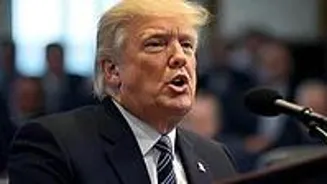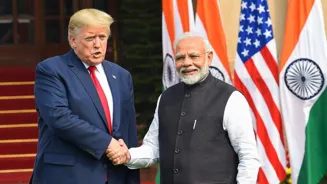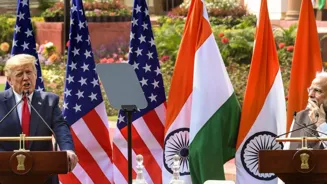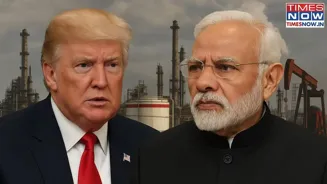India and the US have deepened their partnership across multiple sectors, driven by shared interests, democratic values, and strong people-to-people ties. Key areas of collaboration include defence, technology and innovation, space, semiconductors, biotechnology, cybersecurity, advanced telecommunications, clean energy,
However, India's relations with the US, which were progressing from strength to strength, are now facing serious challenges. Some experts are even saying that President Donald Trump has sent Indo-American ties to the drawing board.
Indeed, a comprehensive US-India trade deal has hit several roadblocks and is currently facing uncertainty. The US has imposed a 25 per cent tariff on a broad range of Indian goods, effective August 7, 2025. This comes despite previous indications of good
In addition, President Trump has signed an Executive Order imposing an additional 25 per cent tariff on Indian imports. He has said that these additional tariffs are because India is purchasing Russian oil. That will raise the total tariff on Indian imports to the United States to 50 per cent which is among the highest tariff rates imposed by the US. India has 21 days to respond to the additional tariffs before they go into effect.
A major point of contention is the US’ demand for greater access to India's agricultural and dairy sectors. India has consistently resisted, citing concerns about the livelihoods of millions of small farmers and potential disruption from subsidised US products. India is also pushing for the removal of the recently imposed tariffs and further reductions on other products, such as steel and aluminium, to gain a competitive advantage over other countries.
The situation is deteriorating further as
US, over its
India, however, maintains that its relationship with Russia stands on its own merits and that its energy purchases are vital for its economy. India has said that such targeting by the US was “unjustified and unreasonable” in light of continued and substantial Western trade with Moscow. In a statement issued on August 4, India's Ministry of External Affairs said, "Europe-Russia trade includes not just energy but also fertilisers, mining products, chemicals, iron and steel machinery and transport equipment. Where the US is concerned, it continues to import
The Indian government has also decried the executive order on additional tariffs. India has said, "It is therefore extremely unfortunate that the US should choose to impose additional tariffs on India for actions that several other countries
However, the important question is whether the position taken by India will diffuse tensions with the US or escalate them even further. Going by past trends, Trump is unlikely to be swayed by the undeniable logic contained in India's statement, as it runs counter to his own stand. Being a businessman, Trump brings a transactional approach to diplomacy. His style
An article entitled ‘India Defies Trump on Russian Oil Despite Tariff Threats’ in The Wall Street Journal(August 5) states that “India is digging in its heels and resisting pressure from the US to curb purchases of Russian oil, despite threats by President Trump to retaliate by imposing higher tariffs on India”.
Affairs could escalate tensions.
The US tariffs could potentially damage India's economy in several ways. They will increase the cost of Indian products for American consumers, making them less competitive compared to goods from other countries not subject to these tariffs or to lower tariffs. The tariffs could put Indian exports at a disadvantage in the US market compared to competitors like Vietnam and Bangladesh.
Sectors heavily reliant on exports to the US, such as gemstones and jewellery, textiles and apparel, pharmaceuticals, and potentially auto components, are likely to experience the most significant negative impacts. India supplies a significant portion of US pharmaceutical needs. Tariffs could lead to decreased demand, potentially impacting earnings for Indian pharmaceutical companies
which derive a substantial portion of their revenue from the US market. A decline in export orders could lead to
The American tariffs on India, which was hiked to 50 per cent, citing Delhi’s continued buying of the Russian oil, could also potentially reduce the country’s GDP growth by a significant amount. Further penalties imposed by the US could weaken capital inflows and investment in India. Thus, Trump’s tariffs could be considered a near-term headwind for the Indian equity market and could contribute to volatility.
In short, a comprehensive bilateral trade agreement remains elusive. India-US tensions are escalating and are likely to continue doing so in the immediate future. US tariffs could hurt India's economy by making its exports less competitive, potentially impacting key industries and potentially slowing down its overall economic growth, while also straining the diplomatic relationship between the two countries.
The tariffs and the likely penalties linked to India's purchase of Russian oil have already
There are also geopolitical factors at play which India cannot ignore. Trump has moved closer to Pakistan, with which he has historically had a complex and sometimes tense relationship. It cannot be forgotten that in January 2019, Trump had said that the US had given Pakistan 33 billion US dollars in aid, and in return, Pakistan had given only lies and deceit. He is now speaking about Pakistan in a completely different tone. Trump's approach also raises concerns about the potential elevation of Pakistan as preferred regional partner
It's widely acknowledged that high-level diplomatic intervention can sometimes achieve remarkable results in international relations. One wonders whether the need of the hour is for Prime Minister Narendra Modi to step in and stem the rot. After all, the strategic India-America bilateral relationship built over decades is now also at risk.
PM Modi has repeatedly said that solutions to problems can only be found through dialogue and diplomacy. He has
What sort of concessions can PM Modi offer?
India has often used TRQs (tariff rate quotas) which involve a two-tiered system. A specified quantity of a particular agricultural product can be imported at a lower or even zero duty. Imports exceeding this quota face a higher tariff rate. India currently has TRQs for commodities like corn, sunflower oil, rapeseed oil and milk powder. While India has reportedly offered TRQs to the US, the
According to a report prepared by the US Department of Agriculture, top agricultural prospects for US exporters include cotton, dairy products, ethanol, fresh fruit, forest products, processed food and beverages, pulses, and tree nuts. According to this report, India has tremendous potential to be a large consumer of many of the high-quality and diverse agricultural products that the United States has to offer.
The US is seeking to significantly expand its
India is a significant consumer of corn, particularly for animal feed, human consumption, and increasingly for ethanol production. While it's also a notable producer, recent trends show a growing domestic
animal feed, and the growing biofuel industry.
The Indian government's decision to promote ethanol production from corn has significantly increased demand, leading to a surge in imports. Corn is a crucial component of animal feed, especially for poultry and dairy, and the expansion of the livestock sector also contributes to the rising demand for corn. While India is a major
Likewise, India is a significant importer of soybeans and soybean oil. While India is no doubt a major producer, its domestic production is not sufficient to meet the growing demand for edible oils and animal feed. In fact, India is a big importer of soybean oil, with imports often exceeding domestic production. India relies on imports to meet a significant portion of its soybean oil needs,
with a large percentage coming from countries like Argentina and Brazil.
While China remains the largest export destination for US soybeans, India is seen as a growing market, especially for soybean oil. The war in Ukraine has led India to seek alternative sources for vegetable oils, potentially boosting soybean oil imports from countries like the US. India had restricted imports of Genetically Modified soybeans but had also temporarily relaxed these
restrictions in 2021 and 2022 to address
To whatever extent is feasible, India could offer the US some more TRQs on specific American agricultural products like corn, soybeans and nuts while maintaining higher tariffs for quantities exceeding the quota. This could help to provide some concessions to the US in sectors where it is demanding greater market access while still protecting domestic industries.
Dairy product imports remain a sensitive sector in India, where cultural and dietary preferences influence food choices,
In conclusion, Trump’s tariffs and the penalty he is likely to put on India for purchasing Russian oil have undeniably introduced a new layer of complexity to the US-India relationship with significant geopolitical implications for India's foreign policy choices, economic trajectory, and regional standing. The tensions with the US are assuming dangerous proportions and the situation
cannot be brushed off lightly.
The writer is a retired
















